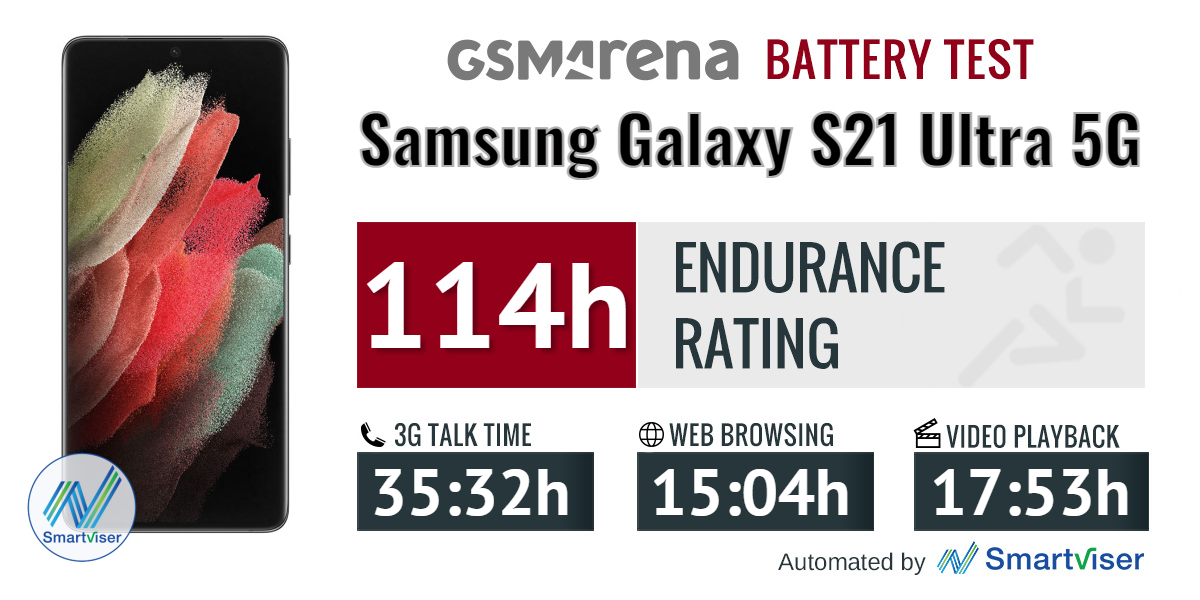Introduction
This year, the Galaxy S21 series came earlier than expected, and it brought a slew of changes. The Galaxy S21 and S21+ now feature lower-res OLEDs, no microSD expansion, and no chargers in the box. Meanwhile, the Galaxy S21 Ultra is what the original Ultra should have been - jam-packed with high-end features, no asterisks, no fine print. Still no charger, though.
The original S20 Ultra was supposed to be the greatest Galaxy to date, but it fell short of that. You could enjoy a 120Hz refresh rate, but only at a lower 1080p resolution. The telephoto camera was advertised as 5x, but it was, in fact, 4x, and let's not even start with the Space Zoom. The ultrawide camera had a great sensor, but it couldn't do macro shots due to the lack of autofocus. The battery was large, but battery life was poor. You get the point.

Well, the Galaxy S21 Ultra makes up for everything. It has a large 1440p screen with native 120Hz support, adaptive at that. It also brings two dedicated telephoto snappers - one for 3x and another one for 10x optical zoom. Its ultrawide camera does feature autofocus, which works for macro shots. The new Ultra also offers ultrawide-band support, and surprise, surprise, S-Pen support as well. This has to be the first non-Note Galaxy phone to offer that - one for the history books.
There is no S-Pen socket on the Galaxy S21 Ultra, and neither is there a bundled stylus. But you can use any S-Pen that's been in circulation, as well as the newly announced S-Pen for S21 Ultra and the upcoming S-Pen Pro. Samsung has also opened the S-Pen to third-party companies that make Wacom-based styluses, so you can expect even more options in the upcoming months. Finally, you can store the stylus in your pocket or opt for some S21 Ultra cases with dedicated pen holders.
The Galaxy S21 Ultra is the only S21 model to come with a 1440p OLED screen, unlike the previous generation. And even better, it now supports 120Hz at that high resolution, so you don't need to choose between high res and high refresh rate. This new Ultra screen also supports Adaptive Refresh Rate that can vary between 10Hz and 120Hz, just like the Note20 Ultra.

The latest Galaxy bears the latest chipset, of course. All international models use the new Exynos 2100 SoC by Samsung, while the USA and China will be getting devices running on the Snapdragon 888 instead. The RAM has been bumped to 12GB, and there is a limited 16GB model, too.
The camera has seen a welcome upgrade. The wide snappers remain relatively the same - a 108MP shooter with f/1.8 26mm lens and a 12MP cam with f/2.2 13mm optics, but now it features autofocus. The zoom system has been completely revamped, though - it now features two 10MP imagers, one for 3x optical zoom and another for 10x optical zoom via a 240mm periscopic lens.
Other flagship tidbits worth mentioning - a 40MP selfie eye with AF, stereo speakers, Wi-Fi 6e, 5G connectivity, ultrawide-band support short-range communication, fast wired and wireless charging for the large 5,000mAh battery.
This year isn't off to a good start for the fans of the rich retail bundles, though. Like Apple and Xiaomi, Samsung has removed the chargers and headphones from the retail boxes and ships each Galaxy S21 only with a cable.
Let's take a deep dive in the specs now.
Samsung Galaxy S21 Ultra 5G specs at a glance:
- Body: 165.1x75.6x8.9mm, 227g; Glass front (Gorilla Glass Victus), glass back (Gorilla Glass), aluminum frame; IP68 dust/water resistant (up to 1.5m for 30 mins), Stylus support.
- Display: 6.80" Dynamic AMOLED 2X, 120Hz, HDR10+, 1500 nits (peak), 1440x3200px resolution, 20:9 aspect ratio, 515ppi; Always-on display.
- Chipset: Exynos 2100 (5 nm) - International, Qualcomm SM8350 Snapdragon 888 (5 nm) - USA/China: Octa-core (1x2.9 GHz Cortex-X1 & 3x2.80 GHz Cortex-A78 & 4x2.2 GHz Cortex-A55) - International, Octa-core (1x2.84 GHz Kryo 680 & 3x2.42 GHz Kryo 680 & 4x1.80 GHz Kryo 680 - USA/China; Mali-G78 MP14 - International, Adreno 660 - USA/China.
- Memory: 128GB 12GB RAM, 256GB 12GB RAM, 512GB 16GB RAM; UFS 3.1.
- OS/Software: Android 11, One UI 3.1.
- Rear camera: Wide (main): 108 MP, f/1.8, 24mm, 1/1.33", 0.8µm, PDAF, Laser AF, OIS; Ultra wide angle: 12 MP, f/2.2, 13mm, 1/2.55", 1.4µm, dual pixel PDAF, Super Steady video; Telephoto: 10 MP, f/2.4, 70mm, 1/3.24", 1.22µm, dual pixel PDAF, OIS, 3x optical zoom; Telephoto: 10 MP, f/4.9, 240mm, 1/3.24", 1.22µm, dual pixel PDAF, OIS, 10x optical zoom.
- Front camera: 40 MP, f/2.2, 26mm (wide), 1/2.8", 0.7µm, PDAF.
- Video capture: Rear camera: 8K@24fps, 4K@30/60fps, 1080p@30/60/240fps, 720p@960fps, HDR10+, stereo sound rec., gyro-EIS; Front camera: 4K@30/60fps, 1080p@30fps.
- Battery: 5000mAh; Fast charging 25W, USB Power Delivery 3.0, Fast Qi/PMA wireless charging 15W, Reverse wireless charging 4.5W.
- Misc: Fingerprint reader (under display, ultrasonic); Stereo speakers; NFC; FM radio (Snapdragon model only; market/operator dependent); Samsung DeX, Samsung Wireless DeX (desktop experience support), ANT+, Bixby natural language commands and dictation, Samsung Pay (Visa, MasterCard certified), Ultra Wideband (UWB) support.
The Note10 was the one to retire the 3.5mm jack, and now the Galaxy S21 is retiring the microSD slot. Samsung makes up for that with a minor price difference between the 128GB and the 256GB models - just €50. It's up to you to decide whether this compensation is enough, though.
There are some omissions, too, this time - inside the retail box.
Unboxing the Galaxy S21 Ultra
Well, well, well, how the tables have turned?! It was just last October when Samsung mocked Apple for not including chargers with the latest iPhones. And a mere two months later, Samsung was caught scrubbing these jabs off the internet in preparation for the launch of its own charger-less flagship.
It's not the first time Samsung had done this, is it? We still remember how the audio jack mockeries disappeared overnight, foreshadowing the jack-less Galaxy Note 10.
So, the Galaxy S21 Ultra is the first Samsung phone to come without a charger or headphones. The maker joins Apple and Xiaomi in a quest to make the planet cleaner, and this ought to make a positive impact eventually. It just requires one small sacrifice from you, the user - you need to buy a USB-C charger if you don't own one and keep it for the long haul.
The thin Galaxy S21 Ultra box contains a USB-C-to-C cable and the phone. That's it.

The Galaxy S21 pre-orders do include various freebies such as a 25W charger, Galaxy Buds, and even a SmartTag, so you aren't without options. Samsung switched to USB-C chargers since the Note10 and S20 generations, so the chance of you having one isn't that big, and it's a good thing you can now grab it for free.
Our Samsung Galaxy S21 Ultra also came with one very thin protector, almost invisible in fact, applied in the factory. It's plastic and will be good only against scratches, but it's still better than nothing.
Design, build, handling
There are two ways to look at the new Samsung Galaxy S21 Ultra - as a welcome redesign and a fresh take on a rather dull shell, or a ruggedly handsome attempt gone sideways and looking like a project done in haste instead.
The Galaxy S21 Ultra is remarkably successful in pulling the sleek industrial look; we'd give it that. While its front is entirely screen, like on all recent Galaxies, the frame and the back are different. See, Samsung made the aluminum frame wider, and the rear panel now has shorter curves.
 S20 Ultra and S21 Ultra
S20 Ultra and S21 Ultra
Then there is the glass back, which is now matte, and we love the frosted feeling we get while touching it. It's awfully slippery, yet thoroughly enjoyable.
Finally, there is the new camera island, wait, no, it's a whole continent now! And the frame extends unnaturally around this monstrosity in an odd attempt to make everything click, but instead breaking the design. And this is where the Galaxy S21 Ultra becomes a take-it-or-leave-it affair. You either see the beauty in this awkwardness, or you are looking at a deal-break.
The new Ultra isn't as large as the old one. In fact, due to the slightly smaller screen, it is a tad shorter. But even though it is no thicker or heavier than the S20 Ultra, the S21 Ultra feels bulkier because of its shorter curves.

While it's mostly a matter of perception, we can't simply ignore the feeling. The new Ultra feels big and bulky. We thought the same for the iPhone 12 Pro Max, but having spent some time with the Galaxy S21 Ultra, we would definitely pick the new iPhone over this Ultra as far as design is concerned, of course.
 The iPhone 12 Pro Max and the S21 Ultra
The iPhone 12 Pro Max and the S21 Ultra
But design isn't everything, is it? And since it is entirely subjective, we are putting a stop to the shapes and feelings talk and moving on to the essential things. Build and features!
The Galaxy S21 Ultra has a brand-new Dynamic AMOLED 2X screen, and it's the most premium panel Samsung has put on a smartphone to date. It's a 6.8" 1440p OLED with an adaptive 120Hz refresh rate. You can enjoy fluid 120fps on the native 1440p resolution this time. It is not a curved screen but is protected by the latest Gorilla Glass Victus with a 2.5D edge, so the front isn't entirely curve-less.

This new screen also features a Wacom-sensor layer for S-Pen support. The Ultra has no stylus socket, but you can get a case that allows you to holster one along with the phone.

There is a small punch-hole for the big 40MP selfie camera, just like on the S20 generation and the rest of the S21 series. Above the screen is the earpiece behind a barely noticeable grille. This is also one of the two stereo speakers.
Invisible to the naked eye is the under-display fingerprint scanner. It is the latest Qualcomm's 3D Sonic Gen 2 sensor, which promises a 77% larger area and 50% speed increase over the Gen 1 used on S20 and Note20 series.

It turns out the sensor isn't as invisible as we thought. Expose the screen to some bright light, and voila - we can see the fingerprint sensors on both the S20 Ultra and S21 Ultra. And the new one is promisingly larger - it is indeed an 8mm square, while the S20's was a 4x9mm rectangle. It works peachy, too, so we do believe what Qualcomm's promised is true.
 You can see the larger fingerprint sensor in bright light
You can see the larger fingerprint sensor in bright light
The Galaxy S21 Ultra comes with a thin plastic protector pre-applied in the factory. It works great with this type of scanner, but it sure isn't the best shield as far as cracks are concerned. But if you opt for a third-party glass, it may and probably will diminish the ultrasonic scanner's accuracy and speed, so be warned.
Now, let's take a peek at the back. The rear panel is also a Gorilla Glass, though not the Victus kind, and is curved towards the frame. The curves aren't as long as the ones on the S20 Ultra hence the bulkier impression.

The back Gorilla piece has a matte finish, and it looks marvelous and feels lovely when touched. It is as slippery as the S20 Ultra's glossy back but is far less prone to fingerprints. Even after a day of use, the back looks relatively clean, which is something we rarely see these days.
Then there is the new Ultra quad-camera sitting at the top of a metal mountain. The first column contains the 12MP ultrawide camera, the 108MP primary and the 10MP 10x telephoto. The second one has the laser-AF tech, the LED flash, and the 10MP 3x snapper.
The whole piece seems somewhat fitting the design - as if the phone had been one big solid block before the camera island was chiseled out. We'd leave for you to decide whether that's cool or not.

The metal plate has a brushed finish and fits perfectly next to the matte glass. Here fingerprints stick easier, though.
The phone wobbles a lot, but given the size of the camera - it's to be expected.
The aluminum frame is glossy, including its camera extensions. It gets smudged in seconds and isn't that easy to clean. Its top has two lonely mics, while there is nothing on the left.
The right side packs the volume and the power keys.

The bottom is rather crowded - it has the (dual) SIM slot, the mouthpiece, the USB-C port, and the second stereo speaker. The microphone is next to the SIM tray and looks just like its ejection hole, so be careful there.
The Galaxy S21 Ultra doesn't offer a 3.5mm jack as it was retired a while ago. But it also omits a microSD expansion, and we can officially name the S21 generation 'the SD killer'.

Handling the Galaxy S21 Ultra is a mixed bag. The phone's weight increases the risk of dropping it. It is especially uncomfortable to hold with one hand when shooting photos or videos, so we would strongly recommend buying a case.
 Galaxy S21 and S21 Ultra
Galaxy S21 and S21 Ultra
We feel like Samsung made all the right choices for the Galaxy S21 Ultra design - it is a phone of a great and solid build of premium materials. We do like the new matte back and frosted metal around the snappers. It is as water-resistant as always, but we aren't sure everyone will appreciate the new look and approach to the main camera. It is also one of the slipperiest phones around, so extra care, or better a case, is a must.
The best OLED screen to date
This year, Samsung has kept the best screen exclusive to the Galaxy S21 Ultra. It is the only in the S21 trio to offer a 1440p screen, while the rest of the S21 were somewhat demoted with regular 1080p screens. All of them support adaptive 120Hz refresh rate at the native resolutions, including the Ultra, which is a first for Samsung.

The Galaxy S21 Ultra features a 6.8" Dynamic AMOLED 2X screen of 1,440 x 3,200 pixels or 515ppi. The S20 Ultra had a 6.9" display, but the difference is quite negligible. The panel is protected by a Gorilla Glass Victus piece.
The screen supports Adaptive Refresh Rate, and it can go as high as 120Hz or drop as low as 10Hz when necessary. It is supposed to be the brightest one, too, with a peak brightness of 1,500 nits! Do not get your hopes too high, though; that number is for HDR video playback and can't be achieved when lighting up the entire screen.
 Galaxy S21 screen next to the S21 Ultra's
Galaxy S21 screen next to the S21 Ultra's
Speaking about HDR, the S21 Ultra supports HDR10+ and naturally, it can play the highest definition content across all popular services - Netflix, Prime, HBO, YouTube.
In our display test, we measured a very good maximum brightness of 458nits. When placed under bright light, the S21 Ultra boosts the screen brightness up to 1023 nits - making this Ultra the second phone to go north of 1000 nits (the first was the Note20 Ultra).
| Display test | 100% brightness | ||
| Black, |
White, |
||
| 0 | 458 | ∞ | |
| 0 | 1023 | ∞ | |
| 0 | 398 | ∞ | |
| 0 | 894 | ∞ | |
| 0 | 504 | ∞ | |
| 0 | 1024 | ∞ | |
| 0 | 416 | ∞ | |
| 0 | 856 | ∞ | |
| 0 | 404 | ∞ | |
| 0 | 823 | ∞ | |
| 0 | 822 | ∞ | |
| 0 | 485 | ∞ | |
| 0 | 807 | ∞ | |
| 0 | 455 | ∞ | |
| 0 | 760 | ∞ | |
| 0 | 498 | ∞ | |
| 0 | 811 | ∞ | |
| 0 | 538 | ∞ | |
| 0 | 888 | ∞ | |
Color rendition is handled the Samsung way with the usual Natural/Vivid approach. Natural aims to reproduce sRGB content truthfully, and we measured an incredibly good average deltaE of 2.
The Vivid mode offers a 5-position cool-to-warm slider. The default mid-point on the slider will get you an average deltaE of 3.2 against DCI-P3 targets, which is nicely accurate despite the slightly bluish rendition of white and gray hues.
A new addition this year is the Eye Comfort Shield. It's yet another implementation of a blue light filter which will adjust the display color according to the time of day (the default Adaptive setting), or let you pick a pre-set interval to engage and do so at an intensity of your choosing.
Now, let's talk about the refresh rate. There are two settings available to you - Standard (60Hz) and Adaptive. The Galaxy S21 Ultra remains in 60Hz for whatever it is that you're doing if you have the phone set to Standard.
The Adaptive mode is, well, adaptive. You'd be looking at 120Hz whenever you're touching the phone with a drop to 60Hz a couple of seconds after your last interaction. That is the general behavior for most things like the UI, browsers (Chrome, Firefox, Samsung's own) and social media apps (Facebook, Instagram, TikTok), and it is the most natural of approaches.

There are exceptions, though, with most of them being video apps. In YouTube, for example, the phone remains at 120Hz when you're playing back HDR videos but drops to 60Hz for 30/60fps non-HDR videos or 48Hz for 24fps videos.
In Netflix and Amazon Prime Video, the S21 Ultra will behave similarly - 120Hz for high-res HDR content, 60Hz for 30/60fps SDR content, and 48Hz for 24fps SDR content. You also get 120Hz in the UI when you touch the screen, otherwise 60Hz.
The Galaxy S21 Ultra also unlocks its high refresh rate for many popular titles that are known to go above 60fps. Among the ones we tried and got 120Hz were Shadowgun Legend, Mortal Kombat, Dead Trigger 2, 1945 Air Force, Alto's Odyssey, and Pac Man.
And just like on the S21, the S21 Ultra has a 60Hz cap on the camera viewfinder. There is also a 60Hz cap in Google Maps - perhaps Google's own doing there. The Always On Display also works at 60Hz - we expected this to be the place where we'd see the promised 10Hz. Well, it is not. This could be a potential burn-in-related setting, though, which mandates refreshing those pixels every now and then.
Battery life
The Galaxy S21 Ultra is powered by a 5,000mAh battery - the same as the S20 Ultra's. Its screen is a bit more demanding as it supports HRR over the native resolution. But the S21 Ultra also features a newer and more efficient hardware, so we hoped to get a somewhat similar numbers as S20 Ultra's (87h rating, 24h calls, 10h web, 13h video).
Well, the Galaxy S21 Ultra managed to surprise us big time! The total endurance rating of the new Ultra is 114 hours, while the standalone test results read as follows: 35+ hours on call, 15 hours on web browsing, and 18 hours on video playback. We also measured an outstanding standby performance on the default phone state with S-Pen on, AOD off.
We carried out these tests on the native 1440p resolution and the Adaptive refresh rate mode, while constantly monitoring the current refresh rate thanks to Android 11's built-in tool. Our web browsing script refreshes pages every 10s, and every refresh triggered a spike in the refresh rate to 120Hz, which then dropped back down to 60Hz 1-2s later. We reckon that's a behavior fairly representative of real-world use - you swipe on the screen, refresh rate shoots to 120Hz, you then read for a bit, it goes down. As for the video playback, the phone maintained a 48Hz refresh rate throughout the test - since it does actually do that when playing back 24fps content, we think that this, too, is a good representation of real-life usage.

Our battery tests were automated thanks to SmartViser, using its viSerDevice app. The endurance rating above denotes how long a single battery charge will last you if you use the Samsung Galaxy S21 Ultra 5G for an hour each of telephony, web browsing, and video playback daily. We've established this usage pattern so that our battery results are comparable across devices in the most common day-to-day tasks. The battery testing procedure is described in detail in case you're interested in the nitty-gritty. You can check out our complete battery test table, where you can see how all of the smartphones we've tested will compare under your own typical use.
Charging speed
The Galaxy S21 Ultra may be the cream of the crop, but it still won't offer you a charger - you need to buy one if you don't have a USB-C charger at home. The supplied USB-C-to-C cable assumes you're going to have a USB-PD adapter or one of the later QuickCharge 4 cross-standards units. If you have an older charger, let's hope you also have a USB-A-to-C cable as well.

The good news is that Samsung is throwing a free charger on many of its pre-order campaigns. Carriers across the world are doing the same thing (they also did that with Apple's iPhone 12 series). We suspect this free charger promotion will be a one-time thing aimed at getting you a charger that'll last, and it won't happen next year.
Samsung also announced a reduced price for its (cable-less) 25W adapter (TA800N model) - it now costs $19.99 in US, €19,90 across the EU, and £17 in the UK.
The Galaxy S21 Ultra supports USB Power Delivery with PPS on top for up to 25W of power. The 45W charging capability from the older flagship generation is not supported.
So, if you are using the said 25W Samsung adapter, then a 30-minute charge from flat will replenish 54% of the battery. One hour gets you to 95%, while a full charge requires 1:11 minutes. Not bad for a 5,000mAh battery, not bad at all.
30min charging test (from 0%)
- Xiaomi Mi 10 Ultra
100% - Oppo Find X2 Pro
95% - OnePlus 8T
94% - Samsung Galaxy S20 Ultra
64% - OnePlus 8 Pro
63% - Apple iPhone 12 Pro Max
55% - Samsung Galaxy S21 Ultra 5G
54% - Google Pixel 5
41% - Samsung Galaxy S21 5G
40% - Samsung Galaxy S20 FE (15W bundled)
37%
Time to full charge (from 0%)
- Xiaomi Mi 10 Ultra
0:27h - OnePlus 8T
0:36h - Oppo Find X2 Pro
0:36h - Samsung Galaxy S20 Ultra
0:58h - Samsung Galaxy S21 Ultra 5G
1:11h - Samsung Galaxy S21 5G
1:25h - Apple iPhone 12 Pro Max
1:32h - Samsung Galaxy S20 FE (15W bundled)
1:35h - Google Pixel 5
1:54h
The Galaxy S21 Ultra supports wireless charging, too, at 10W+ (as per offic specs) with compatible pads, of which Samsung sells a bunch. The phone itself will also charge other devices wirelessly off its back at up to 4.5 watts - Wireless PowerShare Samsung calls it. You get to pick a cutoff point below which the phone will refuse to PowerShare (30% to 90% in 5% increments).
Also, in settings, you get a toggle to enable/disable Fast charging, the Qualcomm QuickCharge 2.0 compliant Adaptive Fast Charging of old. That's the standard that Samsung had been using for ages before it adopted Super Fast charging - the current PD based solution, for which you get a toggle too (this one is on by default). A third toggle lets you disable Fast wireless charging in case, for example, you have a pad with active cooling or blinking LEDs next to your head at night.
Speakers - loudness and quality
The Galaxy S21 Ultra features stereo speakers in a familiar hybrid configuration - one is standalone at the bottom, while the earpiece also serves as a second speaker. With the phone in portrait orientation, the top speaker handles the left channel, while in landscape, they'll make sure they're playing the correct channel orientation.

The Galaxy S21 Ultra stereo speaker setup scored a Very Good loudness on our speaker test. The sound quality is good, too. The vocals are well presented, the high notes play nice, though there isn't much bass. You can compare it with the iPhone 12 Pro Max - it is one of the few phones with good bass, though this comes at the expense of the higher frequency range there.
Use the Playback controls to listen to the phone sample recordings (best use headphones). We measure the average loudness of the speakers in LUFS. A lower absolute value means a louder sound. A look at the frequency response chart will tell you how far off the ideal "0db" flat line is the reproduction of the bass, treble, and mid frequencies. You can add more phones to compare how they differ. The scores and ratings are not comparable with our older loudspeaker test. Learn more about how we test here.
Android 11 and One UI 3.1 with S-Pen support
The Galaxy S21 lineup launches straight on Android 11, and with Samsung's recent promise for 3 major OS updates, that means your new Galaxy S21/+/Ultra should be eligible to receive Android 14 in 2023.
The Samsung launcher on top of Google's OS is OneUI 3.1 - that's 0.1 more than what we got with the recent updates to Android 11 on last year's Galaxies. The 0.1 increment makes for a subtle difference, not to mention that going from 2.5 to 3 wasn't strictly a leap either, but let's still have a look at the software on the Galaxy S21 family here.
The Galaxy S21 Ultra also comes with a Wacom layer on top of the screen and supports Wacom-compatible styluses, including all S-Pens. Samsung has launched a new S-Pen for this Ultra that's bigger and, well, more pencil-like than the rest, and a Bluetooth-enabled S-Pen Pro is on the way, too. This pen support is exclusive to the Ultra and is, in fact, a first-ever on a Galaxy S phone.

The One UI basics are generally similar to previous iterations though you can spot the occasional change here or there. For example, the default lockscreen shortcuts - dialer and camera, are now monochrome - they used to match the respective apps' colors. Oddly enough, if you pick different apps, they will keep their colors - it's not really a first-party vs. third-party type of differentiation either.
Among the functional changes on the lockscreen is the added wellbeing widget - you can now keep track of how much time you spend on your phone without even unlocking it. Meanwhile, the always-on display settings have been simplified.
Unlocking the phone is best done using the ultrasonic fingerprint reader embedded in the display, and its performance is outstanding - it is the fastest one we've experienced, the conventional bunch included!
So, with the new-gen hardware, the software needs fewer taps to register a print, and that's welcome if minor refinement. The option is there if you want to use face unlock - it can be more convenient in certain situations, if generally less secure since it's just based on the selfie camera.




Fingerprint enrollment and security
Another notable change is that pulling the notification shade covers the entire screen underneath, even if there's just one notification card or none at all. Previously, the portion of the screen below the last notification would remain visible if darkened. While we're here, the quick toggles can now be edited directly from the plus button at the end of the list instead of going into the menu.
Coming courtesy of Android 11, there is now Notification history, too. It's accessed from the Settings menu, so it's not within immediate reach, but it's there for those occasions when you dismissed a notification too quickly and you can't seem to find what it was about. Just make sure to enable it, because it's off out of the box.
Android 11 has a new way of handling notifications for instant messenger apps called Bubbles, and One UI 3 adopts it, too. That's in addition to a previously available similar feature offered by Samsung by the name of Smart pop-up view. You'll find these settings under the 'Floating notifications' submenu, where you can alternatively turn both of them off and opt for the old-school cards only interface.
Bubbles is an extension of the Conversations feature, another new development. You tap on an icon in the initial incoming message notification. It turns into a conversation that you can then minimize to a bubble, or what was known as a 'chat head' - originally Facebook Messenger's default way of dealing with chats.
Smart pop-up view is one of One UI's lesser-known proprietary features. In the pre-Bubbles days, it used to add the chat head functionality to any application of your choosing. Tapping the hovering 'head' icon opens the app in a floating window, which you can further maximize to fullscreen or minimize it again to an icon. Sort of like Bubbles, only slightly different.
Introduced with Google's latest OS version, the new media controls have been implemented in One UI as well. You get a stack of the active audio playback apps right below the quick toggles and swiping to the side switches between the apps.
The Media screen was already available on One UI 2.5 pre-Android 11, and it offers similar functionality for picking the output device or using Samsung's Music share feature.
The volume control panel has gotten a makeover too, and now the four sliders are vertical instead of the horizontal ones of OneUIs past.
Yet another of the native Android 11 improvements that Samsung also includes in OneUI 3 is the ability to pin apps to the top of the sheet with Share options. It's one of those things that make you wonder how come it had to wait until v11 for us to get there. Things are much better now, but still, we'd like to remove options too, because that list could sure use some decluttering.
One more thing that Google tweaked in this year's release is the permission handling, and Samsung's implemented it in One UI 3. With this version, you will now see a new prompt for permissions every time an app requests it, letting you deny permission, allow it only while using the app, or just for this one time. If an app requires constant access to permission, you also get a fourth option that takes you to a setting page where you can provide it. This is done prevents the user from accidentally selecting this option while blazing through the permission dialogs.






Share options pinning • Permissions handling
The settings menu has seen a subtle but meaningful makeover. Subcategories are made more legible by using a dot separator and extra intervals, while recent searches are now shown as bubbles instead of a list. Additionally, there's a newly added feature to search settings by hashtags - for conceptually related things but found in different places in the menu.
The dialer comes with a bunch of cosmetic changes itself. You get to pick one of two layouts for the in-call screen. You can also set up a background image or video for that screen, though it's going to be all the same for all of your calls - you can't have a different one on a per-person basis.
You get a whole bunch of options for using your Galaxy with other devices to enable various use cases. DeX is the proprietary feature that lets you use the phone as the 'computer' and add a monitor and a keyboard for added productivity - it works wirelessly or over HDMI.
Alternatively, the Link to Windows feature provides you with an interface to your phone from your computer so you can copy images to and fro, manage notifications on your PC or even make calls from it.
Another option along those lines but with more limited potential is Continue apps on other devices. This requires you to be logged in to your Samsung account on both devices, hook them up to the same Wi-Fi network with Bluetooth enabled and use Samsung Internet browser or Samsung Notes. You'll then be able to copy and paste text and images across and open the same tabs in the browser.





DeX • Continue apps on other devices • Link to Windows
Other staples of proprietary Samsung software include the Edge panels - the panes that show up when you swipe in from the side and provide tools and shortcuts to apps and contacts. Game launcher, the hub for all your games, which also provides options for limiting distraction when gaming is here to stay as well.
Otherwise, the software package is similar to other Samsung phones, with an in-house Gallery app, the Game Launcher app, and a proprietary file manager. Samsung's Internet web browser is also available on the Galaxy S21 Ultra.





Gallery • Game Launcher • File manager • Internet • Edge panel
S-Pen features
If you are familiar with the S Pen from previous Galaxy Notes, you'd find it easy to use it on this Galaxy S21 Ultra, too. There is also low-latency support in selected apps, which wasn't clear at the time of announcement.
The S-Pen that's sold separately as Galaxy S21 Ultra-exclusive ($39.99) is larger than the Galaxy Note20's, looking and feeling more like a real pen. It has a matte finish and comfortable shape, there is a single button, and, of course, the replaceable pen's head. This looks a lot like the Galaxy Tab S7+ stylus, in fact.
There is also an S-Pen Pro coming, and it will feature Bluetooth connectivity. Now, even if you get a BT-enabled S-Pen from a Note, the Air Actions won't work (you just can't pair it, as this was done by inserting it into the socket - something the S21 Ultra doesn't offer). You'll need an S-Pen Pro for that.

So, at this stage, the Galaxy S21 Ultra supports the basic S-Pen functionality. The more advanced features we've seen on the Note20 and Tab S7 series will come with a software update once the Bluetooth S-Pen Pro launches later this year.
And here are these basic actions.
Screen-off memo is available. Just press the S-Pen button when the phone is on standby and go right ahead and write a note, which you can then pin to the always-on display or save for later reference.

When your S-Pen gets near the display while the phone is unlocked, the Air command menu icon appears. You can either tap on the icon or press the pen button to summon the Air command menu. There are pre-set shortcuts here, which you can customize, and those can be either S Pen features or shortcuts to apps.




S Pen settings • S Pen settings • Air command • Screen off memo
Advanced screenshot capture is one of the S Pen's main use cases. Smart select allows you to take differently shaped screenshots, extract text from them, or pin them on the screen. Alternatively, you can create short GIF animations. Then there's Screen write that takes a fullscreen snap that you can write on with the full set of different pens and brushes (and then crop, if you will).
There are numerous other smaller use cases for the S Pen as part of the Air view set of actions. For example, you can hover over an image in the gallery for an enlarged preview or over a calendar entry for more details. You can also scroll up and down by hovering the S-Pen over the edge of the screen.
The Notes app seems to be featuring low-latency support and feels like you are writing on a real paper. You can convert handwritten text into word files, diagrams to PDFs, drawings and sketches to PowerPoint Files.
Screen write - this takes a screenshot, and you can start writing on that shot immediately. For example, you see something cool on a video, just hit Screen Write, make a doodle or something and share it with your friends. That simple.
Screen Translate is a cool option, too, though it doesn't translate whole sentences, just words. Pick the language and start hovering over the text with the S-Pen. You will start seeing bubbles with the translations.
The Write on calendar feature has made an appearance, but we couldn't find the proper way to use it. It does exactly what the name says - you write on top of the calendar, and that's pretty much it.





Notes app • Notes • Screen write • Screen Translate • Write on Calendar
Live message is quite cool, too, although you will rarely use it. It uses the camera to capture a video during which you can write and doodle on the image. How cool is that? Mostly useless, but cool.
AR Doodle uses the front camera - if a face is found, you can draw doodles on it, and they will stick to the face. Draw horns and capture a video with the said horns. Or a mustache. It is a ridiculous thing, but we are sure it will find its fans.
Finally, PENUP is powered by the PENUP app - it's a drawing app where you can express yourselves by using the S-Pen as a paintbrush and paint a masterpiece. Or use some of the templates and color one by yourself.
Performance and benchmarks
As it is always with Samsung flagships, the Galaxy S21 trio is sold with 2 chipset variants with specific regions getting one or the other. North America and China receive the Snapdragon 888 from Qualcomm, while handsets for the rest of the world are equipped with Samsung's latest Exynos 2100 SoC.
 Note20 Ultra and S21 Ultra
Note20 Ultra and S21 Ultra
The processors in both chips have a tri-cluster arrangement and use the same cores (Qualcomm is said to have tweaked things in the prime core). Headlining these processors is ARM's Cortex-X1, a no-compromise performance-focused design based on the Cortex-A78. Next up is a trio of Cortex-A78s, regular ones, while four Cortex-A55s for more mundane tasks take the total core count to eight.
For all the sameness in the setup, there is a difference in the clock rates, which is somewhat significant. The Exynos numbers read 1x2.9GHz + 3x2.8GHz + 4x2.2GHz, while the Snapdragon spec sheet says 1x2.8GHz + 3x2.4GHz + 4x1.8GHz, and the higher rates may give the Samsung chip advantage for applications that can make good use of multiple cores. For comparison, the Kirin 9000 uses the older Cortex-A77 cores in the performance cluster, but its prime core is ticking higher than either the SD888's or the E2100's (1x3.13GHz Cortex-A77 + 3x2.54GHz Cortex-A77 + 4x2.05GHz Cortex-A55).
On the GPU front, the Snapdragon comes with the Adreno 660 GPU, which Qualcomm says is 35% faster and 20% more energy-efficient than last year's Adreno 650.
The Exynos 2100 employs a Mali-G78 GPU with 14 cores and promises 46% improvement over the last generation. The GPU in the Kirin 9000 has the same Mali GPU but in a maxed-out 24-core configuration, though probably at a lower clock rate.
Both the SD888 and the E2100 are manufactured by Samsung on a 5nm fabrication line - Qualcomm switched from TSMC to Korean foundries for this year's chips' production.
There is 12GB LPDDR5 RAM on either version. If you think that'd be insufficient, you can also get the largest storage model, which employs a whopping 16GB RAM. Storage is always UFS 3.1, and three options are available - 128GB, 256GB or 512GB.
Our Galaxy S21 Ultra review unit has the Exynos chipset inside and has 256GB of storage and 12GB RAM.
Geekbench is a CPU benchmark, and it puts the single-core Cortex-X1 core on top of every other Android phone we've tested to date, better than the Cortex-A77 inside the Huawei Mate 40 Pro. We don't have a Snapdragon 888 reference just yet, though we hope we'll get our hands on the Xiaomi Mi 11 soon enough.
The Apple's latest Firestorm core is still on top with an unfathomable lead, not that it matters that much, though.
GeekBench 5 (single-core)
Higher is better
- Apple iPhone 12 Pro Max
1606 - Samsung Galaxy S21 Ultra 5G
1107 - Samsung Galaxy S21 5G
1032 - Huawei Mate 40 Pro (perf. mode)
1020 - Huawei Mate 40 Pro
920 - Galaxy S20 Ultra 5G (60Hz, 1440p)
910 - Samsung Galaxy S20 FE
906 - Galaxy S20 Ultra 5G (120Hz, 1080p)
904 - Xiaomi Mi 10 Ultra
901 - Huawei P40 Pro+
781
It's a bit different picture on the multi-core test. When running in Performance mode, the Huawei Mate 40 Pro beat the current Exynos, but that's not sustained performance. The combined score isn't significantly better than the Snapdragon 865, but it is quite the improvement over the S20 Ultra's Exynos 990.
GeekBench 5 (multi-core)
Higher is better
- Apple iPhone 12 Pro Max
4240 - Huawei Mate 40 Pro (perf. mode)
3704 - Samsung Galaxy S21 Ultra 5G
3518 - Samsung Galaxy S20 FE
3296 - Huawei Mate 40 Pro
3275 - Xiaomi Mi 10 Ultra
3248 - Samsung Galaxy S21 5G
3238 - Huawei P40 Pro+
3203 - Galaxy S20 Ultra 5G (60Hz, 1440p)
2728 - Galaxy S20 Ultra 5G (120Hz, 1080p)
2697
The raw GPU power is a lot, and the Galaxy S21 Ultra tops our offscreen Car Chase test. Well, unless we count the iPhone, that is. Anyway, the new Exynos's GPU is about 25% more powerful than the GPU inside the old Exynos 990 (Galaxy S20 Ultra) and the Snapdragon 865 (Galaxy S20 FE).
GFX Car Chase ES 3.1 (offscreen 1080p)
Higher is better
- Apple iPhone 12 Pro Max
78 - Samsung Galaxy S21 Ultra 5G
64 - Huawei Mate 40 Pro (perf. mode)
64 - Huawei Mate 40 Pro
56 - Samsung Galaxy S21 5G
54 - Samsung Galaxy S20 FE
52 - Galaxy S20 Ultra 5G (120Hz, 1080p)
51 - Galaxy S20 Ultra 5G (60Hz, 1440p)
51 - Xiaomi Mi 10 Ultra
51 - Huawei P40 Pro+
44
The Galaxy S21 Ultra is the only QHD phone among the new Galaxy S21 series, though, and when the GPU is engaged displaying 1440p games, the S21 Ultra frame rate drops. The score is still quite respectable, of course.
GFX Car Chase ES 3.1 (onscreen)
Higher is better
- Samsung Galaxy S21 5G
60 - Apple iPhone 12 Pro Max
55 - Xiaomi Mi 10 Ultra
46 - Samsung Galaxy S20 FE
45 - Galaxy S20 Ultra 5G (120Hz, 1080p)
43 - Huawei Mate 40 Pro (perf. mode)
43 - Samsung Galaxy S21 Ultra 5G
33 - Huawei P40 Pro+
31 - Galaxy S20 Ultra 5G (60Hz, 1440p)
25 - Huawei Mate 40 Pro
25
The S21 Ultra's Antutu result is the best we've had to date unless we count the Mate 40 Pro's result achieved with some trickery. The S21 Ultra managed to beat the Galaxy S21 and the previous S20 devices by a lot. It's also beaten the iPhone 12 Pro Max!
AnTuTu 8
Higher is better
- Huawei Mate 40 Pro (perf. mode)
686835 - Samsung Galaxy S21 Ultra 5G
657150 - Apple iPhone 12 Pro Max
638584 - Xiaomi Mi 10 Ultra
638497 - Samsung Galaxy S21 5G
584055 - Samsung Galaxy S20 FE
543986 - Huawei Mate 40 Pro
531270 - Huawei P40 Pro+
529687 - Galaxy S20 Ultra 5G (60Hz, 1440p)
528631 - Galaxy S20 Ultra 5G (120Hz, 1080p)
514485
The Galaxy S21 Ultra has the most powerful hardware so far, so without a doubt, it is and will continue to be a powerhouse for the next couple of years. Things are done effortlessly on the Ultra, no matter the app or game, resolution and frame rate.
The Ultra has a sharp 1440p display, which requires more power running games in native mode, and while the phone scores lower on the GPU tasks (compared to 1080p phones) - do not worry; its game performance is still excellent.
We also ran the Wild Life Stress Test within the 3D Mark app, and the S21 Ultra scores a 70% stability rating. It runs rather nice and cool for the first 13 of 20 loops, but its performance degrades from there on as the phone starts throttling to battle the higher temperatures. It gets warm, not hot, and this is after 15 mins of non-stop GPU usage at 100%. This is not representative of real-life gaming, though it's good to know the chipset's threshold.
In real life, we couldn't reach the point where we'd notice throttling, not even when running a game for a long time. And that's more than enough by our books to be happy with the performance and the power management.
Ultra-packed quad-camera
The Samsung Galaxy S21 Ultra has one of the most versatile camera setups available to date and hardware that's worthy of the Ultra moniker. Unlike the Galaxy S20 Ultra, the S21 Ultra offers two telephoto snappers for proper 3x and 10x optical zooms, with no trickery involved.

The primary camera uses Samsung's latest 108MP ISOCELL HM3 1/1.33" sensor with 12,000 x 9,000 pixel grid and 0.8µm pitch. It has a Nona-pixel Bayer filter pattern that allows for 9-to-1 pixel binning, so the effective pixel size becomes 2.4µmm and the resolution 12 MP. The lens in front has a 24mm equivalent focal length and an f/1.8 aperture and is stabilized.
The HM3 sensor features several enhancements over the HM1 (used on the S20 Ultra and Note20 Ultra). This includes improved HDR, low light and autofocus performance.
 Old Ultra next to new Ultra
Old Ultra next to new Ultra
Smart ISO Pro is an HDR technology that captures one high ISO along with one low ISO shot simultaneously. As both are captured simultaneously, this avoids the ghosting of moving objects that is a problem for sequential HDR. Then the two shots are combined into a single 12-bit image. That's 12-bits per channel, meaning the RAW image contains 64 times more color information than a 10-bit image.
The HM3 also features a Low Noise mode, which should improve light sensitivity by up to 50%. Alternatively, in good lighting conditions, an enhanced remosaic algorithm can output full resolution 108 MP images.
Super PD Plus adds micro-lenses to the Phase Detection elements used by the sensor for autofocus. The lenses should improve the measurement accuracy of those elements by 50%, which allows the sensor to accurately track moving objects even in the dark.
The ultrawide angle module is apparently the same as on the S20 and Note20. It's based on a 12MP 1/2.55" sensor with 1.4µmm pixels and uses a 13mm f/2.2 lens that should deliver a 120-degree field of view. But unlike the last generation of flagships, the S21 Ultra does offer autofocus on this camera, and it can take closeups.

The telephoto hardware is entirely different on this Ultra. Now instead of one 4x camera, this one offers two snappers - one for 3x and another one for 10x optical magnification.
The first zoom camera uses 10MP 1/3.24" sensor with 1.22µm coupled with 70mm f/2.4 lens, stabilized. It supports dual-pixel PDAF and offers 3x optical zoom.
The second zoom camera has the same 10MP 1/3.24" sensor with 1.22µm but this one sits behind a periscopic 240mm f/4.9 OIS lens. Dual-Pixel PDAF is available, too, and with this one, you can do 10x optical zoom.
The fifth black hole you see on the back is where the laser emitter and receiver for AF assistance reside.

Over on the front, we are getting the same selfie camera that premiered on the S20 Ultra - a 40MP Quad Bayer shooter. Its pixels are tiny at 0.7µm each, but group 4 of them together, and we are getting a 1.4µm pitch. The 25mm equivalent lens is just wide enough and decently bright at f/2.2. And it has autofocus!
Camera app
Samsung's camera app has a few new tweaks and additions this year. A cosmetic change is the renaming of Live Focus mode to Portrait mode - a long-overdue name change. Single take mode, meanwhile, not only allows you to select the duration of capture but also pick the types of shots you want it to take.
Moving on, Pro mode can now be used on the ultra-wide camera as well, not just the main one. The telephotos are still off-limits to Pros.

Those will probably enjoy Director's view for the video. The S21 Ultra's viewfinder can show you live images from all four cameras at once, so you can pick and switch which one to use for recording. The selfie camera can either be displayed as picture-in-picture, or it can share the screen in a 50/50 split with the rear cameras, and you can also turn it off altogether. Director's view recording is limited to 1080p at 30fps, and only one of the video streams is actually recorded - not all at the same time.
Another video-related development is the relocation of the resolution selector from the menu right into the viewfinder - this one we really appreciate.






Single take 2.0 • Pro Mode on the ultrawide • Director's view • Viewfinder • Settings • Extra modes
Photo quality
The default 12MP photos from the main camera are excellent, even if a bit over-sharpened for our taste. The resolved detail is plenty, the grass looks good, the dynamic range is outstanding most of the time, and the noise is pretty much non-existent.
Due to the binning process, some unpleasantries are visible in more complex areas like those balcony blinds and the wall decoration - these patterns don't look this way, at all. But that's a math problem that's dealt with approximations, and that's why we can't have the most complex patterns as realistic as we would have hope for. The excessive sharpening at times isn't helping this either.
The white balance and the color rendition on the S21 Ultra are very accurate, and that's a rarity with Samsung's cameras. Often the processing goes overboard with the colors.
If you don't like what you are seeing, then you can improve things by opting for a 108MP image and then manually downsizing this huge photo by yourself. The 108MP samples aren't that great in full res - they lack detail, soft and noisy.
The unprocessed downscaled photos are even more impressive with an incredible level of detail, correct complex patterns, stop-on sharpness and outstanding grass. They could be a bit noisier due to the lack of processing.



Main camera, 108MP-to-12MP resized
The ultrawide photos are good, but not great. They are often overprocessed, and you can see a lot of the fine detail being washed out because of that. They look good, with accurate colors and okay contrast, good dynamic, too, but less processing would have been better. We'd prefer some noise and rich detail, rather than noise-less photos with poor detail.
Turning off the Auto HDR could sometimes helps, depending on the scene.
Don't get us wrong, the photos are good, the automatic distortion correction works nice, as well, we just know that this camera has more potential, and its processing algorithm could benefit from some refinements.
Thanks to the autofocus, the ultrawide camera can take closeups, too. If you get close (2cm or more) to a subject, a focus enhancer will immediately pop up. We recommend leaving this thing on - it crops a bit, does some magic to sharpen the photo and improve its detail, and, in the end, it will turn up a better image than simply switching to ultrawide and shooting your cactus or banknote from up close (the last photo was captured this way).
So, the 12MP macro shots from the ultrawide camera, using the automatic focus enhancer, are lovely. They are sharp and colorful, you can see a ton of intricate detail, and that's enough for a good closeup image.






Macro from ultrawide camera, 12MP
The photos from both telephoto snappers are saved in 12MP, meaning the software upscales the 10MP output to 12MP and adds some sharpening to the viola. Why? Why, indeed.
The 12MP 3x zoomed photos are okay - they are detailed enough, with accurate colors and low noise. They also offer a great dynamic range, and you can clearly see what's going on that far.
The images still look a bit overprocessed, and this time that's completely true - in addition to Samsung's standard image processing, here we have additional upscale and sharpening for reasons that are beyond us.
Same goes for the 10x zoomed photos. At first, we thought of them as incredible. Then we began pixel peeping and saw various processing artifacts, especially around moving objects (see the people in the last photo). The foliage is ruined most of the times, too.
The available detail is about average, though the colors are accurate, contrast is good, while the dynamic range is commendable.
Further tweaking via a software update could improve things. In fact, disabling the upscale may even be enough; we can live with the rest as it is.
Live Focus mode has been renamed to Portrait mode in the OneUI 3.1 version of the Samsung camera app, but it essentially does the same thing - isolate the subject by keeping it in focus and blurring the background.
Two zoom levels are available, and the default is a 2x times zoom, sourced from the main 108MP cam - just crop, no upscale. This puts a nice distance between photographer and subject and allows for a flattering perspective while still filling the frame with a head-and-shoulders type of shot.
Subject detection and separation is outstanding, with even complex borders like messy haircuts being handled with superb results. The detail is excellent in the regular photos, and pretty good in the zoomed samples. The colors are great, as is the contrast.
Thanks to the proficient detection, you can enjoy various portrait effects, if that's your thing.
Now, let's look at some night shots.
The photos coming from the main camera are okay, but not what we expected from a flagship of such caliber. We expected incredible sharpness and exposure, what we got is average detail, a lot of noise, and clipped highlights. The phone shoots at high ISO settings refusing to let shutter speed go as low as we'd expect - almost as if the camera was not stabilized.
The Night Mode automatically decides the exposure time; for the main camera it is usually 2 seconds. And it is a game-changer.
The photos taken with the Auto Night Mode are impressive with just the right sharpness, pretty good detail levels, very low noise, superb color saturation, restored highlights and well-developed shadows. Yes, we did like the Night photos a lot!
The 12MP ultrawide photos are usable and retain good colors, but this is the best we can say about them. They are poor in detail, the noise is pretty high, and they are rather dark.
Night Mode once again is doing a commendable job - it gets rid of the noise, massively improves the exposure, restores clipped highlights and exposes more detail in shadowy areas, and it offers much better colors. If you need to shoot an ultrawide photo at night, the Night Mode is a must.











Ultrawide cam Night Mode, 12MP
The native 3x camera triggers most of the time. If the app thinks the light is insufficient, it will use the main camera instead (fourth and seventh image).
The 12MP photos from the 3x tele snapper are okay, all things considered (upscale and all). They offer enough detail, and the noise is kept reasonably low. If you are shooting reasonably lit scenes, you will be happy with the photos.
Night Mode is available on this camera, too, and it's incredible. It takes about 5 seconds, and the wait is worth it. The Night Mode 3x photos are just as great as the rest - with improved detail, excellent exposure and saturation, low on noise.
The long-range 10x telephoto also triggers most of the time, unless you are trying to take photos in pitch dark conditions - then the camera app resorts to digital zoom over the 3x tele.
So, the 10x photos are pretty good, too. There is a lot visible on them, the noise is surprisingly low, the colors are accurate, and you can pry where other phones can't reach.
Night Mode works on the long-range tele, too. It helps to improve the exposure, but other than that - you won't get a better image than the standard mode. In fact, you may get worse - a blurry one. We don't recommend the Night Mode unless your phone is stable, but we appreciate the availability of the feature.







Telephoto 10x Night Mode, 10MP
If you see the Moon clearly from your location and you have the Scene Optimizer turned on, you should be prompted to use Moonshot enhancer when switching to a telephoto camera. The feature uses the long-range 10x snapper, and it recommends using the 30x digital zoom option. You can even use 100x zoom, if you are feeling adventurous.
Well, the photos we took of the Moon aren't bad and will do just fine for a few Instagram squares.
We also shot our usual posters with the Galaxy S21 Ultra. Here's how it stack-up against the competition. Feel free to browse around and pit it against other phones from our extensive database.



Samsung Galaxy S21 Ultra 5G against the S20 Ultra 5G and the iPhone 12 Pro Max in our Photo compare tool
Selfie camera
The Galaxy S21 Ultra borrows the selfie camera from the S20 Ultra - a 40MP Quad-Bayer shooter with autofocus. It saves 10MP images, but you can opt for 40MP, too.

Samsung's bizarre handling of zoom levels for selfies will stay with us for at least one more generation, apparently. See, there are two zoom modes - native 25mm equiv. resulting in a 10MP photo and zoomed 32mm equiv. saving a cropped 5MP photo. The selfie camera always defaults to a cropped-in view instead of starting with whatever zoom setting was last used. And why would it go back to the crop if you're switching between Photo and Portrait modes, even though you've specifically zoomed out? It's beyond irritating!
The selfie photos are among the best we've seen from a smartphone, so that's quite the silver lining. The resolved detail is plenty, the dynamic range is great, the colors are spot-on, everything looks good and not over the board.
You can shoot in full 40MP resolution, and the high-res photos turned out incredibly detailed. If you like to capture even more detail, this is one of the rare occasions where we would highly recommend the high-resolution option.
We also liked the portrait selfies - the algorithm does an impressive job separating the subject and convincingly blurring the background.
Video recording and quality
The Galaxy S21 Ultra supports 4K video capturing at 60fps across all five cameras, selfie included. Additionally, you can also shoot 8K@24fps clips with the primary cam, even if the chipset is theoretically capable of 8K@30fps.

The default codec for videos is h.264, but you can switch to the more efficient h.265 in the app menu. 8K is encoded using h.265 regardless of that setting. HDR10+ capture is also possible, a format you can then display on the phone itself, but also on a wide selection of compatible TVs.
Audio is always captured stereo with 256Kbps.
Pro video mode opens up some more frame rate possibilities - 4K and 1080p at 24fps for that cinematic look, as well as 1080p at 120fps, the non-slow-mo variety. Naturally, this mode allows for a lot more creative control and lets you tweak image parameters and monitor and adjust mic gain and direction of pick up.
The 8K footage has a bitrate of 80Mbps, and it's not good at all. In fact, we still think of this option as overkill and a PR stunt, but hey, it's there. The 8K videos coming out of the Galaxy S21 Ultra are barely usable in full res as they suffer from compression artifacts, plus they are awfully soft.
The 4K videos shot at 30fps (38Mbps bitrate) are very good across all five cameras - main, ultrawide, tele 3x, tele 10x, and selfie. Even if they are not the sharpest we've seen from a flagship, they offer good enough resolved detail and excel in everything else - contrast, colors, dynamic range, noise suppression.
The advertised 4K@60fps options are disappointing, though. The 60fps clips are captured with a very high bitrate - 70Mbps - nearly double the 30fps, yet they offer half as much detail and look rather soft. We've put the 60fps in a playlist to avoid chaos on this page.
You can enable electronic stabilization on all snappers, if needed, and it works on top of the optical one. It works great, and it's been probably a few years since we last saw an EIS option that wasn't up to par.
Finally, closing this camera section off, here is the Galaxy S21 Ultra 5G in our video comparison database.



2160p: Samsung Galaxy S21 Ultra 5G against the S20 Ultra 5G and the iPhone 12 Pro Max in our Video compare tool
Daylight shootout: Galaxy S21 Ultra vs. S20 Ultra vs. S21
A flagship camera can't do without a shootout, so we asked ourselves what we would have liked to see in this review. We decided the first thing people would like to know is how the new Ultra camera is faring against the old one and whether there are any major differences between the S21 Ultra camera and the regular S21 shooters. And now come the photos.

The Galaxy S21 Ultra daylight photos are slightly better than the S20 Ultra's - they offer better dynamic range thanks to the new HDR processing and offer a more accurate color rendition. The new Ultra photos are a bit over-sharpened, though.
The Galaxy S21 samples look a lot like the Galaxy S21 Ultra. We had to pixel-peep a lot, and the two minor differences we found are the slightly toned down sharpness on the regular S21 images and traces of noise here and there.
All three Galaxies have the same 12MP ultrawide camera, AF or no AF. And naturally, all three of them output the photos with equal quality. The old S20 Ultra has a slightly warmer color saturation, but that's the only (minor) difference.




Galaxy S21 Ultra, ultrawide cam




Galaxy S20 Ultra, ultrawide cam
The Galaxy S20 Ultra has a 4x telephoto camera that defaults into 5x zoomed mode. Naturally, the S20 Ultra images offer higher magnification at the expense of sufficient detail and upscaling artifacts.
The Galaxy S21 Ultra and S21 both have 3x zoom cameras with different sensors and optics - 10MP with 70mm zoom lens vs. 64MP with 29mm lens. The Ultra upscales its output to 12MP, while the S21 crops the center of its large sensor and then upscaling the content. Well, the Ultra offers the better shots, obviously - its native 3x images are sharper and less noisy.




Galaxy S21 Ultra, 3x telephoto cam




Galaxy S20 Ultra, 5x telephoto cam
There was no doubt that real 10x optical zoom (S21 Ultra) would be better than a digital one done over a 4x camera (S20 Ultra). You can compare both 10x options and see clearly the superiority of the native 10x camera.




Galaxy S21 Ultra, 10x zoom (optical)




Galaxy S20 Ultra, 10x zoom (digital)
Low-light shootout: Galaxy S21 Ultra vs. Galaxy S21
The Galaxy S21 Ultra low-light photos from the primary camera aren't impressive, but they are an improvement over the S21's as far as noise-handling is concerned.
The S21 images, on the other hand, retain a slightly better color saturation.
We also shot these scenes with Night Mode, and the photos from both S21 phones are virtually identical.




Galaxy S21 Ultra, main cam Night Mode




Galaxy S21, main cam Night Mode
The ultrawide snappers are identical on both S21 models, and so are their low-light photos.




Galaxy S21 Ultra, ultrawide cam
Same goes for when using Night Mode - it yields similar images on both phones.




Galaxy S21 Ultra, ultrawide cam Night Mode




Galaxy S21, ultrawide cam Night Mode
Both Galaxy S21 phones have 3x tele cameras, but they save entirely different photos. The ones coming from the Ultra are more detailed, with very-well handled noise and much better dynamic range. You can clearly see more detail in shadowy areas.
Using Night Mode on the tele snappers improves the quality further, though the S21 is still lacking a bit - the Ultra once again offers sharper images, with less noise and better dynamic range.




Galaxy S21 Ultra, 3x cam Night Mode
Low-light shootout: Galaxy S21 Ultra vs. Galaxy S20 Ultra
The Galaxy S21 Ultra low-light photos from the main camera aren't impressive, but they are better than those shot on the S20 Ultra. The noise-reduction does a better job on the S21 Ultra, and the color saturation is better.
The differences when using Night Mode are melted down to slightly better exposed darker areas on the S21 Ultra and sometimes - a notch better saturation. But we had to stare in those pixels really hard to notice these minor changes.




Galaxy S21 Ultra, main cam Night Mode




Galaxy S20 Ultra, main cam Night Mode
It's really tough to tell apart the samples from the ultrawide shooters as they use the same sensors. There are negligible differences here and there, but for all purposes - these shots are the same. And they all look bad.




Galaxy S21 Ultra, ultrawide cam




Galaxy S20 Ultra, ultrawide cam
The Night Mode improves the ultrawide shots on both phones, and once again - they save indistinguishable photos.




Galaxy S21 Ultra, ultrawide cam Night Mode




Galaxy S20 Ultra, ultrawide cam Night Mode
We also snapped zoomed photos side by side with both Galaxy Ultra. The S20's 5x photos are obviously more zoomed in, but they lack in detail. In fact, they looked like cropped and upscaled versions of the ones we took with the S21 Ultra 3x cam - same noise, exposure, and colors just zoomed a bit more.
Absolutely the same conclusion is valid for the Night Mode telephoto samples - the ones from the S20 Ultra looked like cropped and upscaled versions of the S21 Ultra. Yes, that identical.




Galaxy S21 Ultra, 3x cam Night Mode




Galaxy S20 Ultra, 5x cam Night Mode
Conclusion: The S21 Ultra seems to offer minor improvements over the S20 Ultra and S21 as far as primary, ultrawide, and 3x telephoto quality is concerned. But none of these other phones offers native 10x zoom - that's exclusive to the S21 Ultra, and as far as versatility goes - the new Ultra is unmatched.
Alternatives
The new Galaxy Ultra impresses with three key features, and it will be remembered for those novelties - the new 120Hz Quad HD OLED and its S-Pen support, and the versatile quad-camera on the back that relies on real optics instead of some hybrid trickery.

Yes, the Galaxy S21 Ultra is the all-powerful Galaxy right now, and that alone is enough to sell it. It's the Ultra model - meaning there is no better phone on the market today. Indeed, there isn't.
The Xiaomi Mi 11 Pro isn't even official yet, Huawei is yet to unveil the P50, and we are yet to see recent Huawei devices with Google app integration. The OnePlus 9 is unannounced as well, while the next iPhones are far ahead in the future.
Speaking of iPhones, Samsung really outdid itself by dropping the charger immediately after Apple's done it. It could have waited a year or announced it a year ahead to allow a transition period, but it's Samsung - some things are done in the heat of the moment. Like saving the planet, for example.
And that's the reason while the Apple iPhone 12 Pro Max comes as our first suggestion. The Max costs as much as the Ultra, and subjectively, it's the prettier and supposedly sturdier device. The iPhone also impresses with performance and LiDAR scanner if you have the use of it, that is. The camera performance is somewhat on par with the Galaxy as far as primary and ultrawide shooters are concerned. The iPhone cannot match the zoom capabilities of the Ultra, plus it runs on iOS, so if you've invested in Android apps, there are two major deal-breakers right there.
Thinking about the camera, we just can't but mention the elusive Xiaomi Mi 10 Ultra (about $950). It's officially sold only in China, but if you value a complete package with an outstanding camera - this is the one, folks. It has a 120Hz 1080p OLED, Snapdragon 865 chip, and stereo speakers to get you started, but we found its quad-camera (0.5x + 1x + 2x + 5x) to be among the best on the market as far as photo quality is concerned. This Ultra also comes with a 120W adapter, which recharges its flat battery for 27 minutes, so there is that, too.
Another limited-edition phone that comes to mind is the Google-less Huawei P40 Pro+. It has a 1200p 90Hz OLED and one of the best camera configurations money can get you on a handset - 50MP primary, 8MP 3x, 8MP 10x, 40MP ultrawide, and 3D ToF. Indeed, that's a similar setup to the Galaxy S21 Ultra, and Huawei's cameras save some incredible photos. The P40 Pro+ stock is scarce but not that hard to find. It costs about €800/£900 - meaning it is cheaper than the Ultra. Then again, no Google on it.
Back to more popular and easier to find choices - the OnePlus 8 Pro seems relevant even 10 months after its launch. It solved the 120Hz Quad HD OLED conundrum way before Samsung; it runs on a powerful Snapdragon 865 chip; and it offers a reasonably good quad-camera on the back with a 48MP primary, 8MP 3x tele, 48MP ultrawide, and a 5MP color filter cam intended for some artsy shots. The OnePlus 8 Pro runs on the especially smooth Oxygen launcher and is €500 cheaper than the Galaxy. Sure, it can't offer 20% more powerful chip, 10x zoom and S-Pen support, but do these cost €500? You decide.




Apple iPhone 12 Pro Max • Xiaomi Mi 10 Ultra • Huawei P40 Pro+ • OnePlus 8 Pro
The verdict
If you've stayed with us that long, you've probably noticed we are conflicted about this Galaxy S21 Ultra. It is the perfect smartphone on paper, even without a microSD expansion and a bundled charger. But we've had ups and downs while using it for the past week. By the end of this review, we realized the good stuff far outweighs the bad, and most of what we didn't like could be fixed with an upcoming update.

The Galaxy S21 Ultra absolutely deserves its Ultra insignia - it has the best OLED screen with Wacom layer at that, the most powerful hardware, one of the largest batteries, good stereo speakers, and pretty advanced camera system. We were thoroughly impressed by the screen performance and the battery endurance, like the UI and the S-Pen features, and saw many good photos and videos saved by the various snappers.
We aren't huge fans of the new industrial design - mostly how the camera on the back was made. The phone is large and slippery, making it very uncomfortable to handle without a case. The photo quality wasn't always flagship-grade - Samsung needs to tone down its image processing even if it results in some noise or lesser dynamic range. We've always preferred images with natural-looking processing, and so far, both Apple and Samsung have failed us. Here's hoping that at least Samsung does something in this direction with a software update.
If you are after the best and newest phone on the market - look no further - that's the Galaxy S21 Ultra. It has its issues, but the overwhelmingly good features elsewhere and a patch or two will make up for everything. Samsung is definitely off to a good start this year with its Ultra!
Pros
- The best OLED screen, 1000+nits, 1440p, 120Hz, HDR10+, S-Pen.
- Phenomenal fingerprint scanner performance.
- Outstanding battery life, fast to top-up the 5,000mAh battery.
- Stereo speakers with good loudness.
- The fastest Android chipset, 5G, Wi-Fi 6E, Ultra-Wide Band.
- OneUI is super smooth, clutter-free, S-Pen support.
- The daylight photos are good across the board even if a bit overprocessed.
- The selfies are excellent.
- The 4K30 videos are great.
Cons
- Somewhat bulky and slippery.
- The image processing needs further refinements.
- We don't miss the microSD slot, but some of you might.
- No charger, no headphones in the box.
- Uses different chipsets in different regions.








































































































































































































0 Response to "Samsung Galaxy S21 Ultra 5G review"
Post a Comment